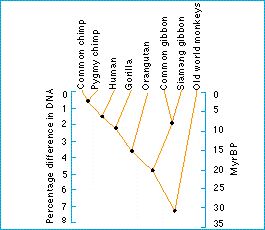The reconstruction of phylogeny - What are the different molecular methods?

Rates of DNA hybridization
A recent method uses rates of DNA hybridization.
Normal double-stranded DNA can be 'melted', to form single-stranded DNA, by heating it up. If single-stranded DNA is then put in (cooler) solution, it will join together again, or 'hybridize'.
The strength of the bond between the two strands is proportional to the similarity of their sequences, and the similarity of the whole DNA of two species can be measured by allowing their DNA to hybridize and then measuring how much lower the melting temperature is for hybrid DNA than the DNA of the single species.
The temperature reduction is proportional to the percentage similarity of the DNA: if the DNA of the two species is very similar it will have to be heated almost to the same temperature as the DNA of the two species before it melts apart; but if they are different, the hybrid DNA will melt at a much lower temperature than the single species DNA.
The relation between temperature and percentage similarity of the DNA is known. The laboratory measurements therefore result in a set of percentage similarities (or differences) for the pairs of species that have been studied, and these can be used as distance statistics. The DNA of humans and chimpanzees, for example, differs on average at about 1.5 % of nucleotides. This is the evidence for the famous claim that the DNA of humans and chimps is 98.5% similar. The figure can be converted into a time to the common ancestor if a species pair can be found for which both the age of their common ancestor and the percentage difference in their DNA is known. The fossil record suggests that Old World monkeys and great apes shared a common ancestor about 30 million years ago, and this figure can be used to convert percentage differences into absolute times.
Figure: phylogenetic relationships of hominoids, as revealed by DNA hybridization.
| Next |



